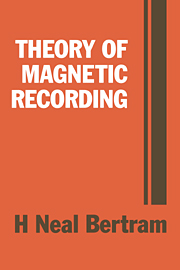Book contents
- Frontmatter
- Contents
- Preface
- 1 Overview
- 2 Review of magnetostatic fields
- 3 Inductive head fields
- 4 Medium magnetic fields
- 5 Playback process: Part 1 – General concepts and single transitions
- 6 Playback process: Part 2 – Multiple transitions
- 7 Magnetoresistive heads
- 8 Record process: Part 1 – Transition models
- 9 Record process: Part 2 – Non-linearities and overwrite
- 10 Medium noise mechanisms: Part 1 – General concepts, modulation noise
- 11 Medium noise mechanisms: Part 2 – Particulate noise
- 12 Medium noise mechanisms: Part 3 – Transition noise
- References and bibliography
- Index
5 - Playback process: Part 1 – General concepts and single transitions
Published online by Cambridge University Press: 02 February 2010
- Frontmatter
- Contents
- Preface
- 1 Overview
- 2 Review of magnetostatic fields
- 3 Inductive head fields
- 4 Medium magnetic fields
- 5 Playback process: Part 1 – General concepts and single transitions
- 6 Playback process: Part 2 – Multiple transitions
- 7 Magnetoresistive heads
- 8 Record process: Part 1 – Transition models
- 9 Record process: Part 2 – Non-linearities and overwrite
- 10 Medium noise mechanisms: Part 1 – General concepts, modulation noise
- 11 Medium noise mechanisms: Part 2 – Particulate noise
- 12 Medium noise mechanisms: Part 3 – Transition noise
- References and bibliography
- Index
Summary
Introduction
This chapter presents the formalism associated with the calculation of playback voltages. Expressions for both real time waveforms, such as isolated pulses, as well as spectra will be derived. The playback process involves low flux levels in the playback head; thus, linear system theory may be utilized to relate a recorded magnetization pattern to the reproduce voltage at the head terminals. The chapter begins with a simple example of the waveform obtained by direct calculation of the playback flux. However, it is generally much more convenient to utilize the formalism of reciprocity. The principle of reciprocity states that the playback flux at any instant is equal to a correlation of the recorded magnetization and the field per unit current of an energized playback head. This principle will be derived and the conditions for its usage discussed in detail. Following that, general playback formulas will be given and specific examples will be discussed for both longitudinal and vertical recording. In this chapter the playback of isolated pulses will be treated. The effects of pulse superposition, ‘linear superposition’, for both the ‘roll-off curve’ as well as linear bit shift will be analyzed in Chapter 6. The discussion will focus on playback by an inductive head. However, since reciprocity may be adapted to magnetoresistive (MR) playback heads, the results presented here apply only with slight modification. Reciprocity as applied to MR heads is discussed in Chapter 7.
In analysis of the recording process the head can be placed either above (e.g. Fig. 5.1) or below (e.g. Fig. 5.3) the medium.
- Type
- Chapter
- Information
- Theory of Magnetic Recording , pp. 107 - 138Publisher: Cambridge University PressPrint publication year: 1994
- 1
- Cited by



